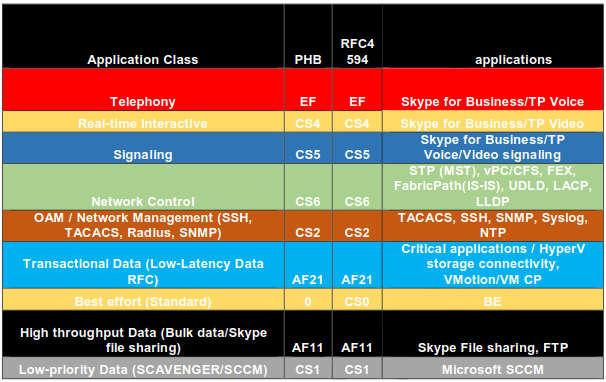dscp
3 TopicsConfiguring QoS for priority queueing and bandwidth reservation
Hi folks, can someone explain how to set up QoS on a BIG-IP to get priority queueing and bandwidth reservation working for packets that are already QoS tagged (L2 CoS, L3 DSCP)? The scenario is the following: Network packets will be marked by the endpoints (or other devices) on Layer 2 (CoS) and Layer 3 (DSCP) according to the following scheme: That being said the packets that enter the BIG-IP already carry their QoS tags. The BIG-IP shall do two things with the packets: The QoS tags must not be changed and remain their original values For every application/traffic class the BIG-IP shall reserve a specific bandwith and assign a priority queue according to the QoS class On the switches and routers the following QoS polices have been implemented which ideally should be the same for the BIG-IP: For the first point (leaving the QoS tags unchanged) I think the solution is to configure the UDP/TCP profiles with IP ToS/Link QoS: Pass Through But how do I accomplish the second point (bandwidth reservation and priority queueing)? In the Network tab I found Class of Service and Rate Shaping, in the Acceleration tab there is Bandwidth Controllers. Which feature is the right one and how does it need to be configured for this scenario? Thx a lot!874Views0likes2CommentsVIPRION DSC between vGuest on the same chassis
Hi, I know it makes not much sense (but when each vGuest is assigned to separate blade?) to create such config but I am curious if it is technically possible or not. In some documents I can see: Members of a Sync-Failover device group should each run on a separate chassis - Overview of vCMP configuration considerations - this is for versions up to 12.1.0 (but includes 11.6.0) For Sync-Failover device groups, each device group member must run on a chassis separate from the other members. - BIG-IP vCMP hosts and guests configuration options - this is for versions up to 11.6.0 So should or must? Or something changed for 12+ Piotr451Views0likes4CommentsOnly one active ctg on an instance allowed
I'm trying to set a DSCP value for an HTTP response based on the MIME type returned from the application services. Things are being tag correctly, but occasionally, I get the following message in the LTM log. Does anyone know how to decipher this to tell me the underlying issue? What is a "ctg"? Category? and what is the "instance" referring to? TCL error: /Common/SND-BWC-Rule - Only one active ctg on an instance allowed.: unable to set bwc app policy 'Media-Category' (line 1) invoked from within "BWC::color set AODefault-BWC Media-Category" iRule when CLIENT_ACCEPTED { log local0. "attached Media-BWC [IP::remote_addr]:[TCP::remote_port]" BWC::policy attach AODefault-BWC [IP::remote_addr]:[TCP::remote_port] } when HTTP_RESPONSE_RELEASE { if { [HTTP::header Content-Type] equals "image/jpeg" } { log local0. "colored Media-BWC Media-Category" BWC::color set AODefault-BWC Media-Category } } Should I just wrap the BWC::color in a TCL exception check to log and ignore this error? Is there a better way to handle or check if a category has already been assigned?186Views0likes0Comments
